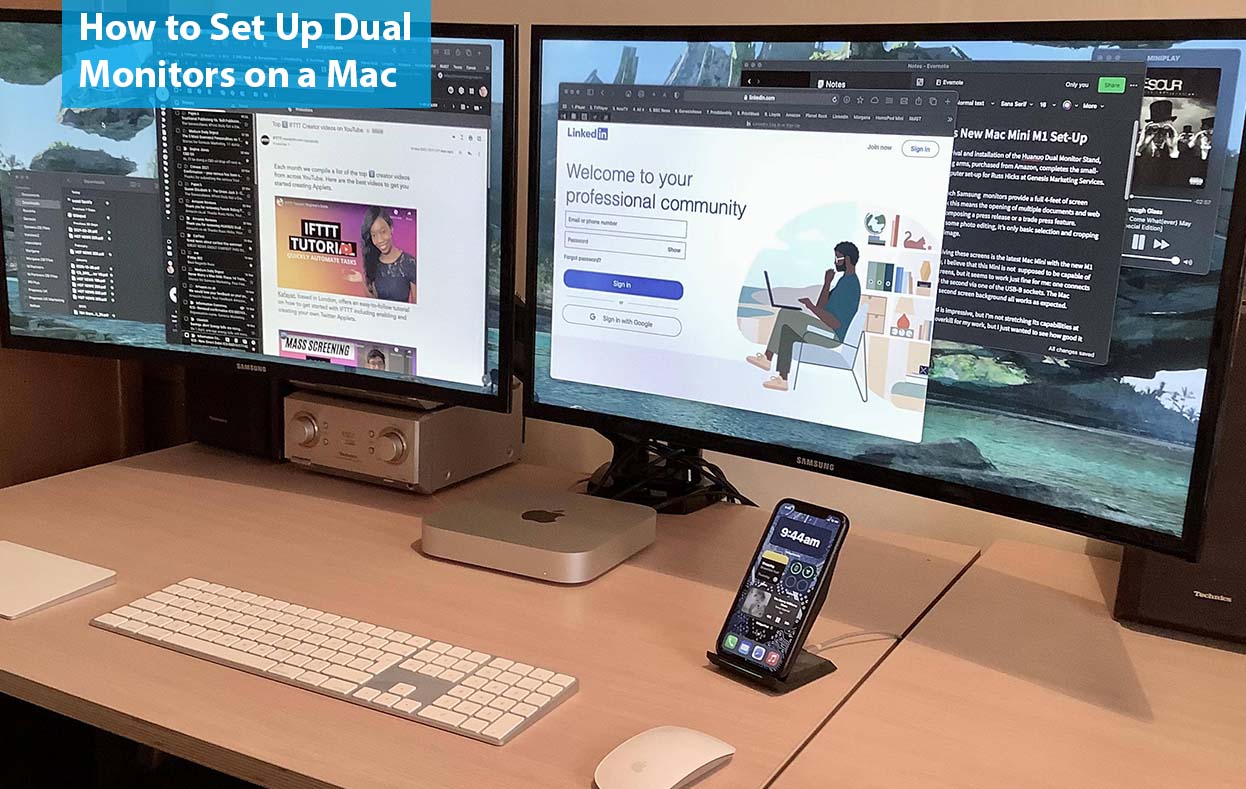In this article, I would be giving you details on how to set up Dual Monitors on a Mac. The process I would be stating below includes how to connect a second monitor to a Mac laptop and how to connect two monitors to your desktop mac.

How to Know your Mac Supports the Monitor You Choose
Right before choosing to settle on an extra monitor or a dual monitor setup, you need to be sure that your Mac is able to handle the resolution. A lot of Macs run and usually exceed 1080p on multiple monitors, but your Mac might not be able to take an extra 4K display.
In other, for you to find out exactly what your Mac can handle, you would be required to check out the technical specifications available on Apple’s website.
Below I have outlined the steps you need to follow in other to find the kind of monitor that your Mac can handle:
- First navigate to “Apple’s Site”, and then select “support” right from the menu bar located at the top of the screen.
- Right on the support page, you can choose to scroll down to “Search for topics” and then enter your Mac’s information (Model, year, etc.)
- Right from the result page, select “list of Models”, then select “identify your model”.
- Scroll down the result page till you find your Mac Model. Then select the Tech Specs link.
- Scroll down to the “video Support” Section. And then look for the dual display and video mirroring bullet point
- This example would should you that a 2011 MacBook Air 13-inch can display its native resolution on the built display while also outputting video to an external display at a resolution of 2560 x 1600 pixels. This basically means that this particular Mac could handle a 1080p display easily, but it would not work with a 4K monitor.
How to Set up Dual Monitors on a Mac
Once you have acquired a monitor for your MacBook or two monitors for a desktop mac, you have verified that your Mac is capable of handling the monitors, and you have either the necessary cables and adapters, you are ready to set up dual monitors on your Mac. Below I have outlined the involved in setting up your monitor on your Mac. The steps include:
- First connect the monitor to the Mac, using the appropriate cable and adapters if required
- Position your monitors and Mac where you would want them to be on your desk
- Turn on your mac. This would automatically detect and activate the second monitor, although the settings might not be to your liking.
- Click on the “Apple Menu” icon
- Click on “system Preferences”
- Click on “Displays”
- Right on your main display, click on “Arrangement”
- On your main display, you need to make sure that the Mirror displays box remains unchecked
- Right on your main display, you would find a diagram that shows the positioning of your displays. If they are not positioned accurately, locate the secondary monitor icon
- Click and drag the “secondary monitor” into the right position
- Release your mouse or your trackpad, and then the second monitor would drop right into the position you desire
- Your monitors would now be ready for use, but you might need to configure the new monitor. Make sure that the image does not look stretched, squashed, or anything. If it does not look right, click on “Scaled”.
- Click on the right “resolution” for the display
- If your second display looks right, you can decide to close the display settings and start making use of your Mac.
How to Force Mac to Recognize a Monitor
you might not be able to work with other monitors just like that, but there are other steps that you can take in other to make sure that your Mac recognizes external monitors. Sometimes, the Monitor not working might be due to faulty hardware, but it could also be something else.
- Make sure that your Monitor is Supported: if you are trying to make use of a really old monitor, the chances here is that it might not be supported by a more modern Mac, or possibly if your Mac has a recent build of macOS.
- Don’t chain connections together: Some monitors that carry older connections need adapters for use with Macs, sometimes more than one. Chaining adapter together sometimes cause the monitor to not be recognized
- Make sure the Cables are Functional: old, broken, or just plain not working Cable might be the reason why your Mac Does not recognize your external Monitor
- Watch out for Adapters: some third-party adapters are not just quality, and may even be total junk. Make sure that you are only purchasing quality hardware.
FAQ
How do you Take a Screenshot on a MacBook Pro?
In other, for you to take a screenshot, press and hold shift+command+3. Make use of Shift+command+4 keyboard shortcut to capture a portion of the screen.
Is MacBook Pro Compatible with all Monitors?
Mostly yes. While a lot of MacBook Pros come with a pretty limited port selection, typically a couple of USB-C ports, there are Mac-Compatible dongles for just about every type of connectivity. Unfortunately, that does not exactly means that you would have to invest in an adapter to make use of those Apple Laptops with monitors that do not come with USB-C connectivity.
How Do I Choose a Monitor for a MacBook Pro?
Although you can use Just about any Monitor with your MacBook Pro, there is a couple of considerations to consider if you would want to make the most of your new display. USB-C connectivity is ideal. Only the newest 14- and 16-inch Macbook pros come with HDMI ports while all other models are limited to USB-C ports for connecting to external displays.



